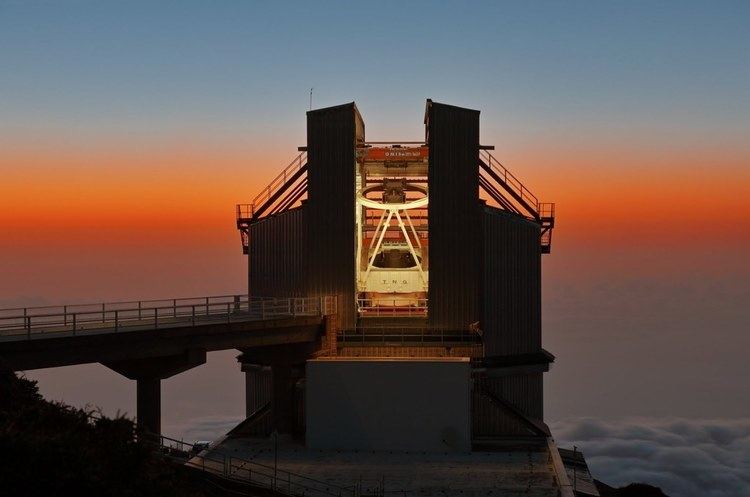Wavelength optical, near-infrared Diameter 3.58 m Phone +34 922 40 55 35 Organization INAF (INAF) | Telescope style Ritchey-Chretien Secondary diameter 0.875 m Year built 1998 (first light) | |
 | ||
Organisation Italian National Institute of Astrophysics (INAF) Location(s) Roque de los Muchachos Observatory, La Palma (Canary Islands) Address Observatorio del Roque de los Muchachos, 38788 Garafia, Santa Cruz de Tenerife, Spain Hours Open today · 7AM–7PMTuesday7AM–7PMWednesday7AM–7PMThursday7AM–7PMFriday7AM–7PMSaturday7AM–7PMSunday7AM–7PMMonday7AM–7PMSuggest an edit Province Province of Santa Cruz de Tenerife Similar Roque de los Muchachos, Caldera de Taburiente National, Oficina de Informaci turística d, La Palma Romántica, Isaac Newton Group of Profiles | ||
Tng il telescopio nazionale galileo a la palma
The Telescopio Nazionale Galileo (TNG, Italian for Galileo National Telescope) is a 3.58m Italian telescope, located at the Roque de los Muchachos Observatory on the island of La Palma in the Canary Islands. The TNG is operated by the "Fundación Galileo Galilei, Fundación Canaria", a non-profit institution, on behalf of the Italian National Institute of Astrophysics (INAF). The telescope saw first light in 1998 and is named after the Italian Renaissance astronomer Galileo Galilei.
Contents
- Tng il telescopio nazionale galileo a la palma
- Bienvenidos al tng telescopio nazionale galileo
- Technical characteristics
- Scientific instruments
- References
Observations at the TNG can be proposed through the Italian Time Allocation Committee (TAC) which assigns, based on the scientific merit of the proposals, 75% of the available time. The rest of the time is at disposal of the Spanish and international astronomical communities. The TNG is open to new proposals two times a year, typically in March–April and September–October.
Bienvenidos al tng telescopio nazionale galileo
Technical characteristics
The TNG is an altazimuthal reflecting telescope with a Ritchey-Chretien optical configuration and a flat tertiary mirror feeding two opposite Nasmyth foci. It has a design derived from the New Technology Telescope (NTT), an ESO 4-meters class telescope located in La Silla (Chile). Therefore, the optical quality of the telescope is ensured by an active optics system performing real-time corrections of the optical components and compensating, in particular, for the deformations of the primary mirror, which is too thin to be completely rigid.
The interface between the telescope fork and the instruments at both Nasmyth foci is provided by two rotator/adapters. Their main function is to compensate for the field rotation by a mechanical counter rotation. The best quality of the TNG is that all the available instruments are permanently mounted at the telescope. This guarantees flexibility during an observing session, since it is possible to change instrument during the night with a loss of time limited to a few minutes.
The science based on observational data from the TNG is varied. Proposed observing programs go from the study of the planets and minor bodies of the solar system up to researches of cosmological interest (e.g. large-scale structure of the Universe and systems of galaxies).
Scientific instruments
The TNG is equipped with four instruments:
Decommissioned instruments:
